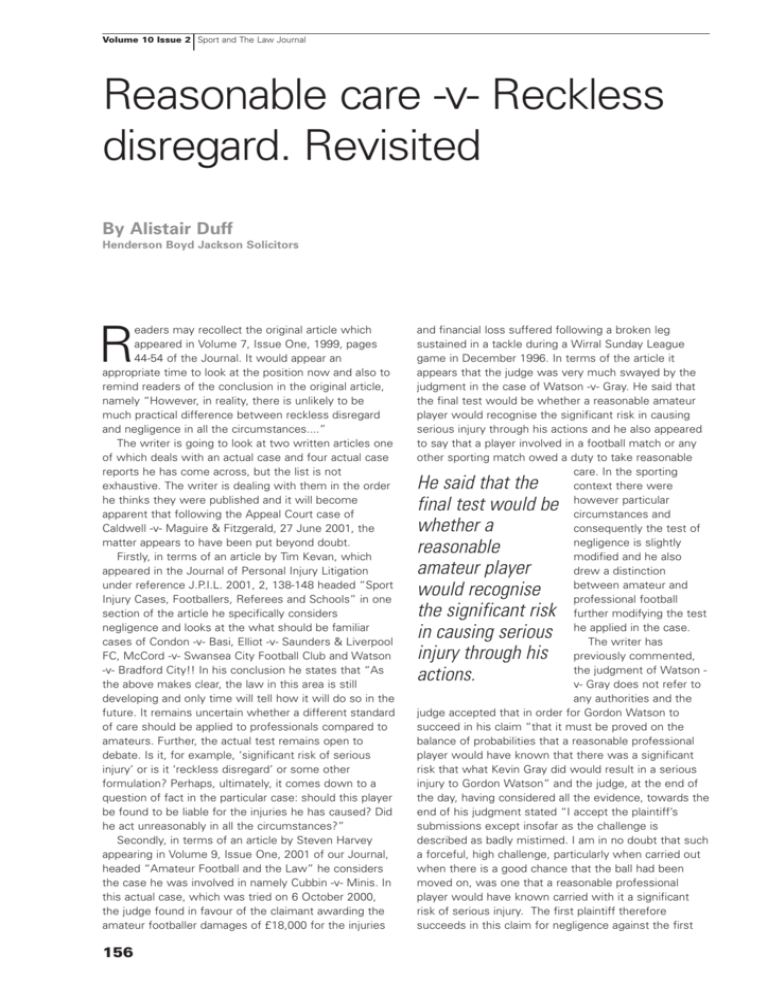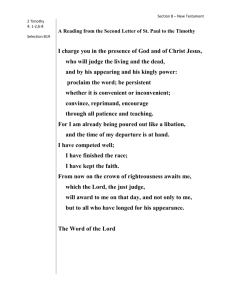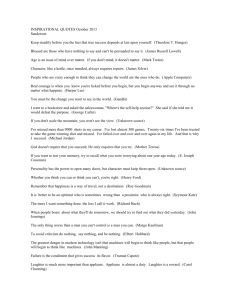v- Reckless disregard. Revisited - British Association for Sport and
advertisement

Volume 10 Issue 2 Sport and The Law Journal Reasonable care -v- Reckless disregard. Revisited By Alistair Duff Henderson Boyd Jackson Solicitors eaders may recollect the original article which appeared in Volume 7, Issue One, 1999, pages 44-54 of the Journal. It would appear an appropriate time to look at the position now and also to remind readers of the conclusion in the original article, namely “However, in reality, there is unlikely to be much practical difference between reckless disregard and negligence in all the circumstances....” The writer is going to look at two written articles one of which deals with an actual case and four actual case reports he has come across, but the list is not exhaustive. The writer is dealing with them in the order he thinks they were published and it will become apparent that following the Appeal Court case of Caldwell -v- Maguire & Fitzgerald, 27 June 2001, the matter appears to have been put beyond doubt. Firstly, in terms of an article by Tim Kevan, which appeared in the Journal of Personal Injury Litigation under reference J.P.I.L. 2001, 2, 138-148 headed “Sport Injury Cases, Footballers, Referees and Schools” in one section of the article he specifically considers negligence and looks at the what should be familiar cases of Condon -v- Basi, Elliot -v- Saunders & Liverpool FC, McCord -v- Swansea City Football Club and Watson -v- Bradford City!! In his conclusion he states that “As the above makes clear, the law in this area is still developing and only time will tell how it will do so in the future. It remains uncertain whether a different standard of care should be applied to professionals compared to amateurs. Further, the actual test remains open to debate. Is it, for example, ‘significant risk of serious injury’ or is it ‘reckless disregard’ or some other formulation? Perhaps, ultimately, it comes down to a question of fact in the particular case: should this player be found to be liable for the injuries he has caused? Did he act unreasonably in all the circumstances?” Secondly, in terms of an article by Steven Harvey appearing in Volume 9, Issue One, 2001 of our Journal, headed “Amateur Football and the Law” he considers the case he was involved in namely Cubbin -v- Minis. In this actual case, which was tried on 6 October 2000, the judge found in favour of the claimant awarding the amateur footballer damages of £18,000 for the injuries R 156 and financial loss suffered following a broken leg sustained in a tackle during a Wirral Sunday League game in December 1996. In terms of the article it appears that the judge was very much swayed by the judgment in the case of Watson -v- Gray. He said that the final test would be whether a reasonable amateur player would recognise the significant risk in causing serious injury through his actions and he also appeared to say that a player involved in a football match or any other sporting match owed a duty to take reasonable care. In the sporting context there were however particular circumstances and consequently the test of negligence is slightly modified and he also drew a distinction between amateur and professional football further modifying the test he applied in the case. The writer has previously commented, the judgment of Watson v- Gray does not refer to any authorities and the judge accepted that in order for Gordon Watson to succeed in his claim “that it must be proved on the balance of probabilities that a reasonable professional player would have known that there was a significant risk that what Kevin Gray did would result in a serious injury to Gordon Watson” and the judge, at the end of the day, having considered all the evidence, towards the end of his judgment stated “I accept the plaintiff’s submissions except insofar as the challenge is described as badly mistimed. I am in no doubt that such a forceful, high challenge, particularly when carried out when there is a good chance that the ball had been moved on, was one that a reasonable professional player would have known carried with it a significant risk of serious injury. The first plaintiff therefore succeeds in this claim for negligence against the first He said that the final test would be whether a reasonable amateur player would recognise the significant risk in causing serious injury through his actions. Sport and The Law Journal Volume 10 Issue 2 and second defendants.” This appears to be a different sort of test based upon whether the plaintiff suffered serious injury or not and this seems rather odd because one could envisage the situation where there is a clearly negligent act - ie an assault on a player by another off the ball but there is no more than minor injury. Does this mean the player cannot recover? Further reverting to Cubbin the comments about a distinction between amateur and profession football again seems rather odd and, as previously mentioned, such comments were raised in Condon -v- Basi, but Mr Justice Drake in Elliot -v- Saunders, albeit obiter, states “I fully accept that the standard of care to be considered is objective, but depends on the circumstances of each case. Lord Donaldson’s added comment that a higher degree of care is required of a player in a First Division match than that of a player in a local league was not necessarily the decision of the court and was therefore obiter. I’d respectfully doubt whether it can be accepted without some reservation.” The writer would refer to Nettleship -v- Weston, 1972 QB 691, where in the Court of Appeal Lord Denning and Lord Justice Megaw held in a case involving a learner driver that the duty of care owed by the learner driver to the passenger/instructor was the same objective and impersonal standard as that owed by every driver, including the learner to passengers, the public and property on and off the highway in the criminal and civil law. Lord Denning, at one point stated “It is no answer for him to say I was a learner driver under instruction. I was doing my best and could not help it. The Civil Law permits no such excuse. It requires of him the same standard of care as of any other driver.” Further, in Jones -v- Manchester Corp, 1952 2 AER 125, a patient died from an excessive dose of anaesthetic which had been administered by a doctor who had been qualified for 5 months. Again in the Court of Appeal Lord Denning said “Errors due to inexperience or lack of supervision are no defence as against the injured person”. The writer respectfully submits that this applies to amateurs and professionals involved in sport as well. Thirdly, we turn to the Court of Appeal judgment given on 27 June 2001 in Caldwell -v- Maguire and Caldwell -v- Fitzgerald, reported in 2002 PIQR, P6, which would appear put matters beyond doubt as all the relevant authorities were cited, which has been one of the problems in the past – namely lack of the citation of all relevant authorities. The case was to do with a professional jockey who was seriously injured whilst riding in a two mile novice hurdle race at Hexham on 30 September 1994. Holland J dismissed his claim for personal injuries against the two respondents who were also professional jockeys and were riding in the same race. The Appeal was heard before The Lord Chief Justice, Lord Justice Judge and Lord Justice Tuckey. Lord Tuckey stated “The appellant’s complaint was that the judge set the standard of care too low; that he effectively required proof of deliberate or reckless disregard for safety. If he had applied the correct standard, in any event, he would or should have found that the respondents were negligent.” Further on he stated “Following the race there was a stewards inquiry at which the respondents were found guilty of careless riding in that they had not left enough room for Byrne to come round the inside rail. They were each suspended for three days.”......... “Two distinguished experts, John Francome and Carl Llewellyn, gave evidence at the trial. They agreed with the finding of the stewards because they thought the respondents should not have taken the inside line unless and until they were one length clear of Royal Citizen. Both should have looked to their left to ensure that Royal Citizen was no longer in contention. As to the law, the judge said that the primary guidance for him must come from the Court of Appeal.” He considered the five relevant cases, namely Condon -v- Basi, 1985 1WLR 866, Wooldridge -vSumner, 1963 2QB 43, Wilks -v- Cheltenham Homeguard Motor Cycle and Light Car Club, 1971 1WLR 668, Harrison -v- Vincent, 1982 RTR 8 and finally 157 Volume 10 Issue 2 Sport and The Law Journal Reasonable care -v- Reckless disregard. Revisited Smoldon -v- Whitworth 1997 ELR 249. Lord Tuckey stated: “From these cases he extracted five propositions ....... and Lord Brennan QC for the appellant accepts the first three of the judge’s propositions of law, but says the last two are unduly restrictive and not supported by the Court of Appeal authorities, which the judge considered.” Proposition [4] was in the following terms “[4] Given the nature of such prevailing circumstances the threshold for liability is in practice inevitably high; the proof of a breach of duty will not flow from proof of no more than an error of judgment or from mere proof of a momentary lapse in skill (and thus care) respectively when subject to the stresses of a race. Such are no more than incidents inherent in the nature of the sport” and “[5] In practice it may therefore be difficult to prove any such breach of duty absent proof of conduct that in point of fact amounts to reckless disregard for the fellow contestant’s safety. I emphasise the distinction between the expression of legal principle and the practicalities of the evidential burden. The judge in the first instance then expressed his conclusions as follows: Each defendant is guilty of lapses of care in the riding of their respective mounts away from the second last hurdle so as to contribute to the premature curtailment of the inside lane otherwise being followed by Royal Citizen and thus so as to contribute to the claimant’s accident...” Further on Lord Tuckey states “Holland J, was referred to a number of other Australian authorities, as we have. It is not necessary to refer to those cases. The relevant principles to be applied to a case of this kind emerge clearly from the decision of this court in Condon and Smoldon, which are binding on us.” (The writer notes that Curtis J, the judge of the first instance in Smoldon -v- Whitworth specifically said “I decline to be drawn into the argument about whether I am bound by the decision in that case or it is of persuasive authority. Either way, in my judgment the case contains a compelling, modern and easily understood statement of the law.”) Lord Justice Tuckey later on commenting on the judge in the first instance’s position stated “In his fourth and fifth propositions, the judge made it clear he was referring to the practicalities of the evidential burden and not to legal principle. All he was saying was that, in practice, given the circumstances which he has identified, the threshold of liability is high. Lord Bingham CJ said the same of the referee in Smoldon......... The judge did not say that a claimant has to establish recklessness. That approach was specifically rejected by this court in Smoldon. As in Smoldon, there will be no liability for errors of 158 judgment, oversights or lapses of which any participant might be guilty in the context of a fast moving contest. Something more serious is required.” The writer specifically notes that Lord Bingham CJ specifically said “The level of care which is required is that which is appropriate in all the circumstances, and the circumstances are of crucial importance. Full account must be taken of the factual context in which a referee exercises his functions, and he could not be properly held liable for errors of judgment, oversights or lapses of which any referee might be guilty in the context of a fast moving and vigorous context. The threshold of liability is a high one. It will not be easily crossed.” Lord Justice Tuckey then turned to the appellant’s second ground of appeal which was namely “He submits that the judge should, in any event, have found the respondents liable..... The Jockey Club’s findings that the respondents were guilty of careless riding supports and establish the view that this was a case of negligence in which the respondents should have been held liable.” Lord Justice Tuckey later on states “The Jockey Club’s rules and its findings are of course relevant matters to be taken into account but, as the authorities make clear, the finding that the respondents were guilty of careless riding is not determinative of negligence. As the judge said, there is a difference between response by the regulatory authority and response by the courts in the shape of a finding of legal liability.” Lord Justice Judge stated at one point in his judgment “I would, however, emphasise two particular points. First, it is clear from the authorities that a finding that a jockey has ridden his horse in breach of the rules of racing does not decide the issue of liability in negligence.........” “ Second, in the context of sporting contests it is also right to emphasise the distinction to be drawn between conduct which is properly to be characterised as negligent, and thus sounding in damages, and errors of judgment, oversights or lapses of attention of which any reasonable jockey may be guilty in the hurly burly of a race......” “The level of care required is that which is appropriate in all the circumstances, and the circumstances are of crucial importance.” This judgment appears to put the matter beyond Lord Bingham CJ specifically said “The level of care which is required is that which is appropriate in all the circumstances, and the circumstances are of crucial importance. Sport and The Law Journal Volume 10 Issue 2 doubt, but as stated in the previous article, in reality there is unlikely to be much difference between ‘reckless disregard’ and ‘negligence’ in all the circumstances. If the latter is applied and taking into account the playing culture, different styles of play and the heat of the moment as relevant circumstances, then sports participants are likely to receive just as effective protection using ‘negligence’ in all the circumstances as the test, as they would under the doctrine of ‘reckless disregard’. The next case to look at is Leebody -v- Ministry of Defence 2001 CLY 4544. This case was a county court case dated 9 July 2001 in which Leebody brought an action against the MOD in respect of personal injuries suffered while playing in a football tournament organised by the Royal Navy. He sustained a serious injury to his leg following an allegedly negligent tackle by a member of the opposing team. The referee took no action and it was left to the senior officer present to forfeit the game. Judgment was granted for Leebody on the basis that the offending player went to tackle him from behind with both legs and that the tackle was deliberately aimed at the man and not the ball, which was two to three yards ahead of Leebody. The tackle was illegal, outside the rules of Association Football and dangerous in all the circumstances. Condon -v- Basi was followed. It doesn’t appear that any other cases were cited. The next case is Pitcher -v- Huddersfield Town Football Club Ltd, (unreported, July 17, 2001 QBD). This was a claim for damages for personal injury suffered by Darren Pitcher, the claimant, as a result of a late tackle by Paul Reid in the course of a Nationwide Division One match played on 31 August 1996 between Crystal Palace and Huddersfield Town. The claim was brought in negligence. The allegation was that in the course of his employment, Paul Reid chased the claimant, who was running with the ball towards the Huddersfield goal. Paul Reid was behind the claimant and to his right. After the claimant has passed the ball, he lunged at the claimant with his left leg and struck the claimant on the outside of the right knee with his left foot, as a result of which the claimant sustained injury to his right knee. It was agreed that the time difference between the challenge and when the ball was played was fractional, namely, about 0.2 of a second. Professional sportsmen, it was argued, Although the judge was satisfied that this was a late and no doubt clumsy tackle in coaching terms, the claimant could not establish that it went any further. must react to events in a matter of split seconds; they have the training and the skill at this level to do so. Although the judge was satisfied that this was a late and no doubt clumsy tackle in coaching terms, the claimant could not establish that it went any further. It was a foul but the judge was not satisfied it was more. It was held to be an error of judgment in the context of a fast moving game where Paul Reid had to react to events in a matter of split seconds. Whatever their training and their skill the judge concluded that First Division footballers are far from infallible. This was held to be the kind of tackle which, although against the rules of the game, occurs up and down the country every Saturday of the football season in Division One matches. The claimant did not succeed in crossing what the judge called “the high threshold” that lay in his path to take this case from a simple late tackle, albeit one with tragic consequences, to one actionable in negligence. His claim failed. (There doesn’t appear there was any authority cited, but the ‘high threshold’ comment, as you remember, is equivalent to what Lord Bingham said in the Smoldon Appeal case.) Lastly, in the case of Gaynor -v- Blackpool Football Club 2002 7 CL 432, 8 November 2001, the judge in the county court of Oldham, dealt with a case where an aspiring professional footballer sought to recover damages when he sustained a serious leg injury during an Under 19s association football match between the youth teams of two professional football clubs. Gaynor alleged that he was kicked high on his leg by C, one of Blackpool’s players, after the referee had blown his whistle for an earlier infringement and after the ball had rolled out of play. C, who was shown a red card by the referee following the incident, contended that he had challenged Gaynor for a 50/50 ball close to the touchline while the ball was still in play. C further submitted that he had not heard the whistle being blown and that Gaynor had injured himself when he lunged at the ball, kicking C high on the knee. The judge gave judgment for Gaynor holding that Gaynor’s version of events was to be preferred. C’s tackle on Gaynor was extremely late, continuing after the whistle and after the ball was out of play. It was unnecessary and carried a high risk of injury. It was executed in such a way that C kicked Gaynor hard enough to break his leg even though Gaynor was wearing shin pads. Caldwell -v- Maguire was applied. In conclusion, it would appear that in any sporting case now, Caldwell -v- Maguire should be cited and will be binding on parties in England. To the writer’s knowledge, the matter is still to be tested in the Scottish Courts. 159







